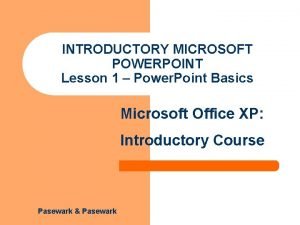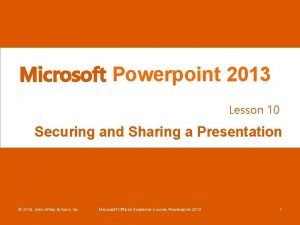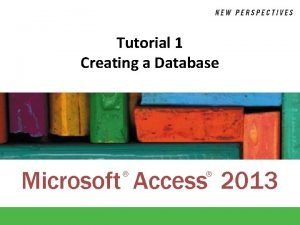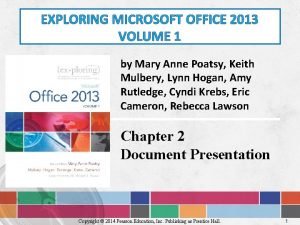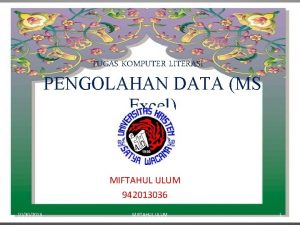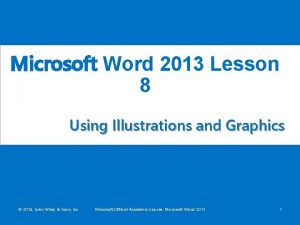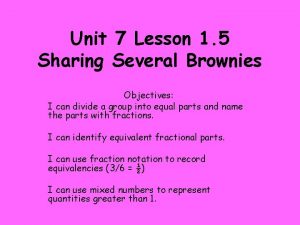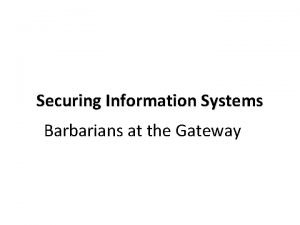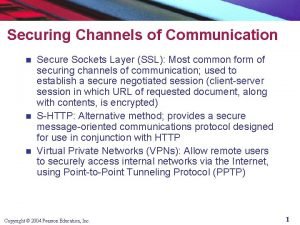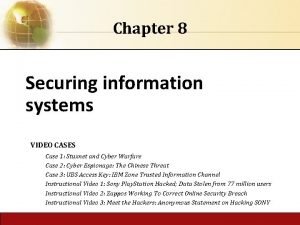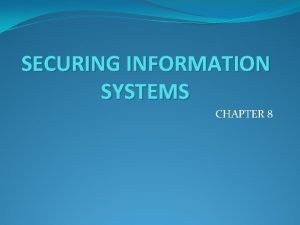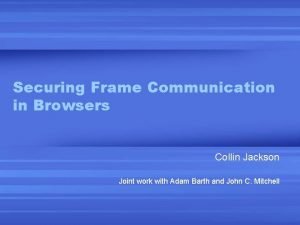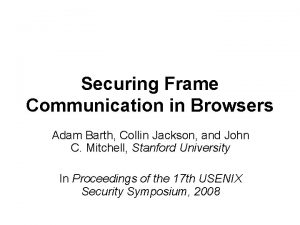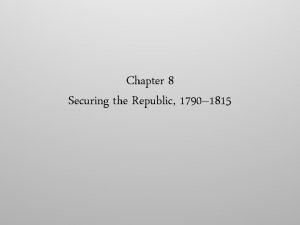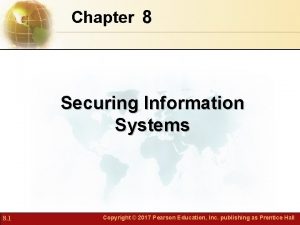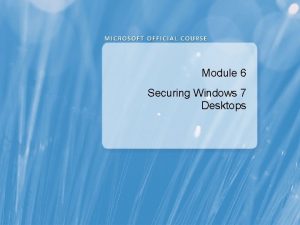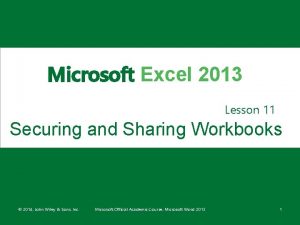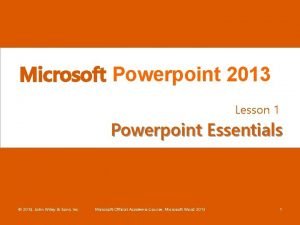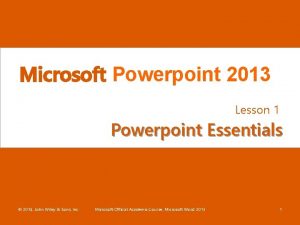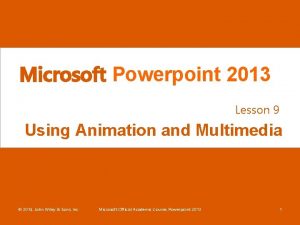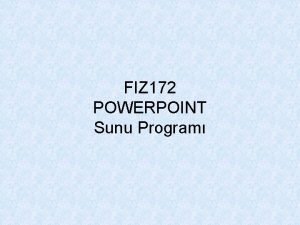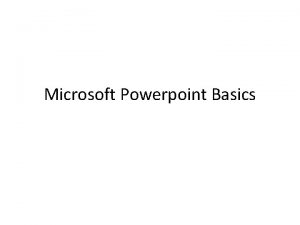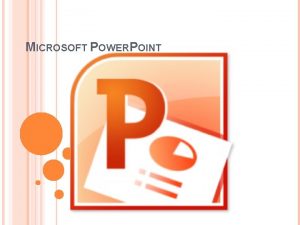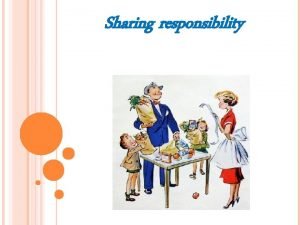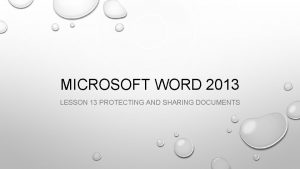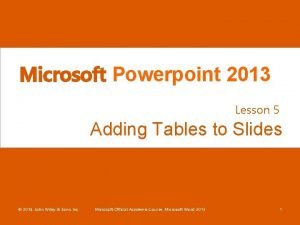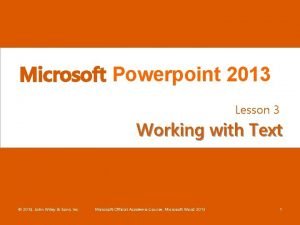Microsoft Powerpoint 2013 Lesson 10 Securing and Sharing


























- Slides: 26

Microsoft Powerpoint 2013 Lesson 10 Securing and Sharing a Presentation © 2014, John Wiley & Sons, Inc. Microsoft Official Academic Course, Powerpoint 2013 1

Software Orientation • Tools on the Review Tab make it easier to add comments to a slide. • Besides allowing you to add comments, the Review tab lets you check spelling, access references like encyclopedias, use a thesaurus, translate a word or phrase or set the current language.

View Comments • A comment is a note you insert on a slide. You can use comments on your own presentation. • The review tab makes it easy to View, insert, edit and delete Comments. • Note the small balloon icon in The upper left corner of the slide Which indicates that the slide Has a comment. © 2014, John Wiley & Sons, Inc. Microsoft Official Academic Course, Powerpoint 2013 3

View Comments • You can click on the Review tab and then show comments. • Another way To display the Comments pane Is to click a Comment balloon. • You can navigate Your way through The comments by Clicking on the next or previous comment. © 2014, John Wiley & Sons, Inc. Microsoft Official Academic Course, Powerpoint 2013 4

Insert a Comment • To add a comment to a slide, use the New Comment button on the Review tab. • Comment markers are color-coded so that if more than one review adds comments it is easy for you to identify the commenter simply by color. • Comments are numbered consecutively as they are inserted. © 2014, John Wiley & Sons, Inc. Microsoft Official Academic Course, Powerpoint 2013 5

Edit a Comment • Comment text should be clear and concise. • You can reword, insert or delete text in the comment box. • Use the Edit comment button to open a comment box so you can modify the text. © 2014, John Wiley & Sons, Inc. Microsoft Official Academic Course, Powerpoint 2013 6

Delete a Comment • You can easily remove a comment from slides when they are no longer needed. • If you point to a comment in the Comments pane, a Delete icon (X) appears in the upper right corner. Click that X to remove the comment. • You can also use the Delete button on the Review tab to remove a comment. • To quickly remove all comments, click the down arrow under the Delete button to open a menu from which you can quickly delete all comments on this slide or in this entire presentation. © 2014, John Wiley & Sons, Inc. Microsoft Official Academic Course, Powerpoint 2013 7

Comments • PPT does not have track changes feature like the one in Word, but you can receive comments and feedback from reviewers by first saving your presentation to your computer, and then posting a second copy to a shared location such as Sky. Drive. You can ask people to make changes and add comments to the shared copy. Once they are done, you can compare and merge the shared copy with the original one saved to your computer. 11/22/2020 8

Compare and Combine Presentations • • Comparing presentations enables you to see the differences between two similar presentation files. You can easily identify the changes that have been made to copy. The Compare feature merges two presentation files. You then can use Revisions pane and the Compare group on the Review tab to see what differences exist between the merged versions and either accept or reject each revision. When you mark a revision for acceptance or rejection, the change is not applied immediately; changes occur only when you click End Review. © 2014, John Wiley & Sons, Inc. Microsoft Official Academic Course, Powerpoint 2013 9

Set a Password • Password-protecting a presentation file ensures that unauthorized users cannot view or make changes to it. • You can set, change, and remove passwords from a file. • You can also mark a presentation as final, which does not provide much security but can prevent accidental changes. • Passwords are case sensitive. • Use the Backstage or File tab to protect your pptx document. © 2014, John Wiley & Sons, Inc. Microsoft Official Academic Course, Powerpoint 2013 10

Change or Remove a Password • You can change a password in much the same way as you created it. • To remove a password entirely, use the same process as for changing it, but change it to a null string (blank, no characters, not even spaces). • Use the File tab and click Encrypt with Password. The Encrypt Document dialog box opens. The password previously assigned will already be filled in. • Double-click the current password and press the Delete key on your keyboard to clear it. • Click OK and the password has been removed. © 2014, John Wiley & Sons, Inc. Microsoft Official Academic Course, Powerpoint 2013 11

Mark a Presentation as Final • When you have completed all work on a presentation, you can mark it as final to prevent any further editing. • When you use the Mark as Final command in a presentation, you can open the presentation and read it, but you can no longer edit it or add comments. • You are also restricted to other activates such as encrypting the document. • Therefore, marking a presentation as final should be one of your lasts tasks when finalizing a presentation. • Use the Backstage View and click Protect Presentation. Select Mark as Final and a confirmation box will appear letting you know that your presentation will be marked as final and then saved. © 2014, John Wiley & Sons, Inc. Microsoft Official Academic Course, Powerpoint 2013 12

Mark a Presentation as Final • Marking a presentation as final does not prevent you from ever making additional changes to a presentation. You can reverse the Mark as Final command by clicking Edit Anyway on the information bar. All features are then available to you again. © 2014, John Wiley & Sons, Inc. Microsoft Official Academic Course, Powerpoint 2013 13

Check for Compatibility Issues and Optimize Media Compatibility • If you need to share your presentation file with someone who uses PPT 2003 or earlier save it in PPT 97 -2003 format from the Save As dialog box. • The file format is the same for PPT versions 2007, 2010 and 2013 so no special translation is usually required for the user to open and view the presentation. • There are some minor compatibility issues among PPT 2007, 2010 and 2013. However, these issues may not be obvious until a user tries to use your file and encounters an error or a feature that does not work as it should. • To minimize the impact of such compatibility issues, you may want to check the file for compatibility problems prior to distributing it. © 2014, John Wiley & Sons, Inc. Microsoft Official Academic Course, Powerpoint 2013 14

Check for Compatibility Issues and Optimize Media Compatibility • Go to File Tab And then click Check for Issues. On the menu that Appears, click Check compatibility. Click Optimize Compatibility and the Dialog box opens and Immediately begins Processing the video clip to improve its compatibility. © 2014, John Wiley & Sons, Inc. Microsoft Official Academic Course, Powerpoint 2013 15

Check for Accessibility Issues • An accessible presentation is one that can Be viewed by a wide variety of computer users, Including those who may have disabilities that Require them to use adaptive technologies such As screen reading programs. Power. Point includes a command that checks the accessibility of your work and offers suggestions for improving it. This is located on the File tab, click check for issues and then click Check Accessibility. © 2014, John Wiley & Sons, Inc. Microsoft Official Academic Course, Powerpoint 2013 16

Modify Properties and Remove Metadata • A file’s properties provide info about the file such as the date and time it was created or last modified, the file size, etc. • The properties also include metadata (which means data about data) such as the author’s name. • In some cases you might want to remove your personal info. © 2014, John Wiley & Sons, Inc. Microsoft Official Academic Course, Powerpoint 2013 17

Saving a presentation in different formats: • There are many formats available for sharing your PPT work with others who may not have PPT or who may prefer to view your presentation in another format. • Each format is suited for a different usage; you choose the best one for you. 11/22/2020 18

Save in XML Format • XML – Extensible Markup Language which is a structured markup language that makes it easier to exchange data files across various types of operating systems and applications. • You a ppt is saved in XML format, it does not seem obviously different from a normal PPT but internally the way the data is stored is different. • Use the Backstage View and click on Save As, use the save as type drop-down list and select a file type. © 2014, John Wiley & Sons, Inc. Microsoft Official Academic Course, Powerpoint 2013 19

Save As a Picture Presentation • A picture presentation looks on the surface the same as any other PPT presentation. However, PPT saves each slide as a graphic and then replaces the slide’s content with that graphic. This tool can be useful in cases where you want to copy individual slides into other applications as graphics. • This is done in the File Tab and you click Export, change file type. © 2014, John Wiley & Sons, Inc. Microsoft Official Academic Course, Powerpoint 2013 20

Save a Presentation as an XPS or PDF File • PDF (portable document format) and XML (XML paper specification) are page layout formats. • They each create platform-independent files that can be displayed on any computer system that has a reader for the format and the files will display and print exactly the same way on any system or any printer. • Either format is great for situation where you want the content to be uneditable. © 2014, John Wiley & Sons, Inc. Microsoft Official Academic Course, Powerpoint 2013 21

Save a Presentation as an Outline • The text from a presentation can be exported as a text only outline that you can open in Word or in any application that supports rtf (Rich Text Format) file type. • Rich text format is a generic file format that is compatible with almost all word processing programs. • Exporting text as an outline can be useful if you need to repurpose the text from a presentation for a different situation. © 2014, John Wiley & Sons, Inc. Microsoft Official Academic Course, Powerpoint 2013 22

Save a Presentation as a Power. Point Show 1. 2. A Power. Point Show file is just a regular presentation file except that it opens in Slide Show view by default. You may want to distribute a presentation in this format if you expect your recipients to have PPT installed on their PCs but to be more interested in viewing the how than in editing it. © 2014, John Wiley & Sons, Inc. Microsoft Official Academic Course, Powerpoint 2013 23

Save a Slide or Object as a Picture • You can export individual slides or objects as pictures. • In the case of a slide, the entire slide becomes a graphic, which you can then use in any application that accepts graphics. • In the case of an object, that individual object is saved as a graphic in any of a variety of formats you choose. © 2014, John Wiley & Sons, Inc. Microsoft Official Academic Course, Powerpoint 2013 24

Saving as a Video • Videos are a great way to distribute self-running presentations to people who do not have PPT. • PPT creates videos in either MPEG-4 Video (mp 4) or Windows Media Video (wmv) format. © 2014, John Wiley & Sons, Inc. Microsoft Official Academic Course, Powerpoint 2013 25

Adding a Digital Signature • Adding a digital signature to any Office software is a great way to reassure others you may share your files with that the files are authentic. • Steps are: 1. File 2. Protect Presentation 3. Add a digital signature 11/22/2020 26
 1 important lesson that is worth sharing about this lesson
1 important lesson that is worth sharing about this lesson Powerpoint lesson 1
Powerpoint lesson 1 Flow chart in powerpoint 2013
Flow chart in powerpoint 2013 Track changes in powerpoint 2013
Track changes in powerpoint 2013 Tutorial access 2013
Tutorial access 2013 Exploring microsoft office 2013 volume 1
Exploring microsoft office 2013 volume 1 Woven mat texture fill in excel
Woven mat texture fill in excel Microsoft access 2013
Microsoft access 2013 Uraikan tentang efektivitas rumus pada microsoft excel 2013
Uraikan tentang efektivitas rumus pada microsoft excel 2013 Clip art microsoft word 2013
Clip art microsoft word 2013 Sharing brownies fraction lesson
Sharing brownies fraction lesson Disadvantages of powerpoint presentation
Disadvantages of powerpoint presentation Securingthehuman sans org
Securingthehuman sans org Securing information system
Securing information system The most common form of securing channel is through
The most common form of securing channel is through Chapter 8 securing information systems
Chapter 8 securing information systems Chapter 8 securing information systems
Chapter 8 securing information systems Chapter 8 securing information systems
Chapter 8 securing information systems Securing network devices
Securing network devices Securing information systems summary
Securing information systems summary Securing frame communication in browsers
Securing frame communication in browsers Securing frame communication in browsers
Securing frame communication in browsers Chapter 8 securing the republic summary
Chapter 8 securing the republic summary Chapter 8 securing information systems
Chapter 8 securing information systems Securing windows 7
Securing windows 7 Securing
Securing Securing windows 7
Securing windows 7

